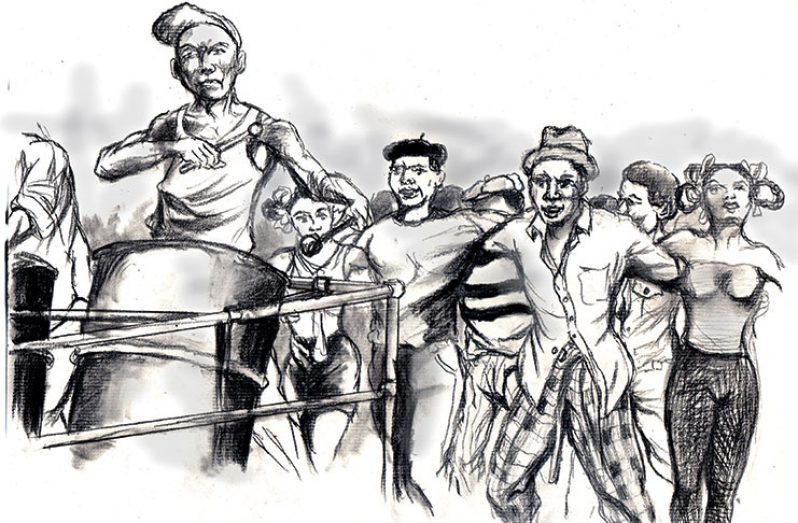“INSSSIDE! Outssside!”
This was the chant of the Steel Band tramp, when road bands took to the streets of Georgetown, with the music of the year lifting spirits and casting a grass root generation into the embrace of the enchanting rhythms of Steel pan.
This was the chant of row-after-row of youths, male and female, with hands embracing each other’s shoulders; with strong bodies unpolluted by addictions tramping for hours, high on music outpoured by tireless steel-pan men, through street-after-street.
Even the timid danced on their bridges, because the multitude of the tramp were at times the toughest this city had bred, and our colonial prejudices for the culture of the steel band and its folk still haunted our social perspectives in the 70s.
The steelband cemented a camaraderie that was loyal by district and to its panmen; that loyalty was needed along the route of the tramp to muscle the wheeled platforms that housed the pans and panmen.
Young folks would know the day before that Silvertones, through Leopold Street, or Invaders from Charlotte Street, or Atlantic Symphony from Campbellville would take the streets and from what time, more likely after work.
NO SURPRISE
Many of the tramps continued in the workdays after Mashramani. That the road band was so important rather than the sound systems that replaced them should not come as a surprise.
The steel band, the football team, the boxing gym, the weightlifting-bodybuilding gym, and under the house where the string-band practised were among other skilled services; the essence of a grassroot community a few decades ago.
But it was the steel pan that introduced and crossed social barriers with the music that those barriers attempted to attribute to themselves.
For many talented grassroot children, their first encounter with concert, jazz and classical music was not the movies nor Madam Ulita Anthony, James Sydney or Rashid Osman on the radio, featuring a classical piece on that specific programme. It was in the pan yard that they would musically converse with Duke Ellington, Beethoven and Puccini, adding to the jute box, punch box and the upgrade sound system’s rich reservoir of popular music across the seasons.
Steel pan culture and its heroes, ‘Pemya’ Rudy Bishop, Camo Williams and the eternal Roy Geddes among a host of others kept that flame alive.
ROAD BANDS OF YESTERYEAR
The Road Bands of yesteryear: Tripoli, Quo Vadis, Silvertones, GUYBA Invaders are all gone. The names of today’s steel bands have been removed from that active stage of people engagement to the point that we hardly know their names, because, like our national festivals, they have become annual features: Exotic, appreciated, but seriously underused.
It will require management to return the steel pan to the active consciousness of the people; management that can sensibly merge art forms with justification to reach and stimulate both cerebral faculties and emotional senses. This can be done, as the facets are there, but just not yet envisioned on the same platform.
Nothing, however, in the interim can fill that void, but the educational experience of visiting a small museum and absorbing the explanations and exciting journeys offered from someone who knows.
THE PAN MUSEUM
One such place; in fact, the only such place that exists for steel pan is located in Roxanne Burnham Gardens.
This is the Pan Museum created by pan icon, Roy Geddes, and it should be one of the mandatory places schools should visit, and then write compositions on their experience.
This Museum needs expanding; pan is too important a cultural experience for the State not to work with Geddes and bridge the incredible efforts of this brother in recognition of what he has housed there.
I lament how this country procrastinates opportunities like the existence of the only pool of steel band history assembled in this country at the museum, without planning for its continuance when this brother is no longer there.
The year 2017 is the first of the next fifty years of building home-grown mental and physical landmarks. The youths of my day, including myself, who tramped to Sparrow’s “Ah come out to mass” in 1976 will not be there to tell that pan story in fifty years, a steel pan story that shaped communities. My anxieties are driven by daily experiences that alert me to the necessity of recording the physical timeline in its profound relevance.
Last year, our Jubilee Year, for Emancipation I suggested at a meeting that the children’s parade should be accompanied by a Steel Orchestra Road Band. I then learnt that no such thing exists anymore. Fact is, the youngster at the Music School possibly never saw a road band in the streets of Georgetown.
Within my lifetime, we are forgetting who we were yesterday. If this persists, somebody will write a history of who we are, within the social spaces between the significant dates that we record to memory; in fifty years, they will remember the events of 1947 and 1966, and 1970 and 2015. But, will they know what transpired socially between those years?
The Roy Geddes Museum is here today. Lest we forget, let’s ensure that it endures the seasons productively.


.jpg)











